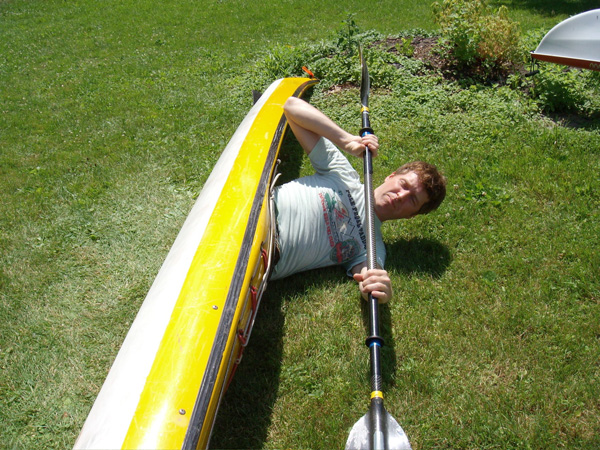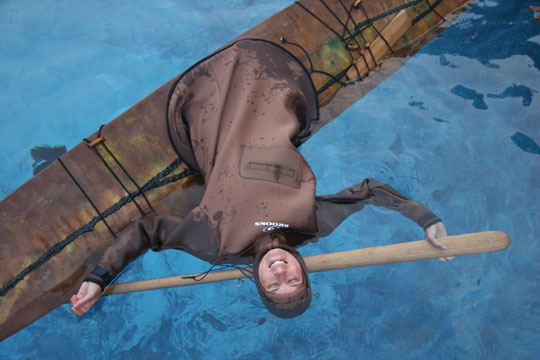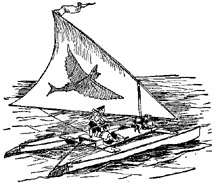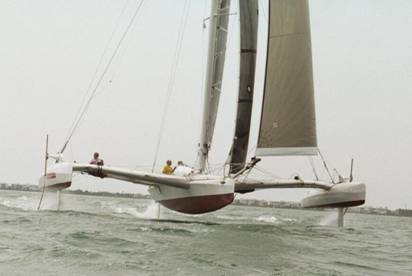More Photos Below!Gallery
This past weekend I borrowed my friend Tim’s sweet sea kayak and took it to a local lake where we were staying a few days at a friend’s cottage and partying for the 4th. Actually, a pal picked it up for me. I didn’t even know it was going to be there—I thought our plans hadn’t gone through. But when it arrived, my heart jumped. Yay! I could hardly wait to get learning how to roll. I know what to do but just haven’t put it all together yet. Of course with kids and party people around this effort was turned into entertainment and part of beach life. Fine by me!
Tim’s boat is a lovely yellow Valley Pintail from England. Deluxe expedition grade. Wow! It fits like a glove and is made for rolling in big water. Tim got his rolls down fairly well in it. My own boat is more of a racer, with a high deck and round hull: tough to learn to roll in!
Why Sea Kayak?
Here’s a bit of why I like sea kayaks… In the summer we mostly ride bikes for fitness and daily errands. I don’t do much arm exercise other than yard mowing and some wood splitting and a little yard-barbells. I only get in a few flatwater paddles in the hot summer anymore—our local water is pretty terrible and we don’t travel much. Our upnorth trailer by the lovely river is a too-far 2.5 hours away, it’s turning out. So: summer is rather hot and dry for us. We have our lovely yard pool for cooling off in, though. Without that I’d be in trouble. 3×15 feet of daily bliss. What’s more, when I do paddle, I tend to stay out of the water. So what’s so great about sea kayaking is how IN THE WATER you are. Sure, you can stay dry, but you can also just lean in and cut a turn and drench your deck to the halfway point and bury your arm into the cool water up to your shoulder, yet you’re still “upright.” Water can be everywhere with a sea kayak yet you’re still secure and in control. I like the idea that the boundary between air and sky and water shifts and swings all over the place. So there. (The small feature photo for this story is of Cheri Perry—a champion roller who knows and shows what it’s like to relax in the kayak’s two-part world.)
Party Fun
To get warmed up for my waterwork at the cottage, I got into the boat in the grassy yard and started rocking it back and forth then onto its side. Then I’d sweep the paddle back and flick my hip to roll me upright. I was practicing the last 2/3 of my roll. I could let the boat roll mostly over top of me then lever myself back upright. What fun.
Off to the water. I shoehorned myself into the high performance hull and paddled around a bit rocking back and forth, practicing braces. Then with various people spotting me on and off during the day I just tried all sorts of things. Wet exits, wet re-entries, emptying and re-entering the boat out in the deep water…and rolling. I nailed one ONCE that first day.
Then it was time for other people to play in boats and for me to swim with kids. They jumped off the swim platform nonstop for an hour—with me spotting them and then helping them swim back to shore.
That evening I had just a couple beers and woke up the next day WASTED. Ugh! It took a long time to get going. Missed early morning fishing. But I finally got going again and the kids went back out for more jumping off the platform. And I got practicing my rolls again. I was going to do it, by Jove! (He was watching, I think…)
A hilarious thing was that because I didn’t think the boat was showing up I didn’t bring my stuff, but my pal brought enough along to work: paddle, skirt, boat. No nose plugs! Rolling practice is usually done with plugs. I found out why! Man, I pumped gallons of water through my sinuses. Whenever I’d come back up I’d basically be vomiting water. Gagging. Spluttering. Hawking loogies. A hilarous mess. But that never slowed me down. I was almost getting it! Well, the 2nd day I kept it up. And I finally got it! I started nailing my rolls. And finally I really got a sense of the deep high brace aspect of rolling. I got into doing half-rolls with really high braces—but with keeping my arms in. I could about dunk my head then brace back up. I’d hold the paddle by one blade for max outrigger flotation. What fun!
Did you know that the eskimos have 35 kinds of rolls?
But here’s the hilarious punchline. Martha was doing quite a bit of swimming and paddling each day, too. When we were packing up in the afternoon of the day when I finally got my rolling down pat, we were exhausted. No partying, it was just the sun, the water and the arm-action, I guess. The next morning we could hardly stand. Felt like a hangover all over again. I was bruised all over and I needed a nap an hour after waking up. I got going OK around lunch. It’s a good thing I had started doing some arm exercise finally the week before! Leg fitness isn’t everything—and of course biking doesn’t prep you for walking, hiking or running. Whew, it’s tough to keep up and what a price to pay when you don’t! I was more tired those 2 days than ever in my life, I think. That’s what a few hours of swimming, sun and strange paddle action will do to someone who’s only been biking! It makes me laugh, the extent of the fatigue.
But it’s so addictive to learn something new. A new skill that I can use every time I go kayaking. Heck, rolling is just plain fun, I can tell. It’s a great way to cool off after paddling awhile in the sun. Here’s a funny thing: many skill paddle-tourists never end up needing to roll. It’s hard to knock a skilled kayaker over who hasn’t gotten himself in over his head to begin with. You’re not supposed to paddle far off shore. For every half mile or so of exposed passage-making you’re supposed to add an equally skilled paddler. Getting back into a boat when paddling with a pal isn’t so tough. But storms do pop up. Or sometimes multiple group members get into trouble at the same time. And one occasionally paddles alone.
A Goal…
My goal… A crazy one. Probably foolish. But I want to paddle across the Straits to visit pals on Mackinaw Island and to attend the Primitive Skills weekend. I’ll take 15 lbs of camping gear along in waterbags in my fore and aft hatches. It’ll be a grand lake tour, really. Island hopping. 3 miles between them, max. I think. I better check a map. I better get a chart. I better paddle and practice my rolls and such every day. But even then: should a first year sea kayaker head out into big water solo like that? No. But I’ve always done everything on my own. We’ll see. I’ll see if someone wants to come along. Two is better than one. I better call Tom!
Background
I’ve always been into sea kayaks. If you’ll be on big waters in a little boat, it’s good if it’s a sea kayak. Sometimes that’s where I am, so my thoughts have always wandered over to those boats. Also, as a boat gets bigger its worries grow exponentially. I have several longtime boat adventure pals who grew up into bigger boats then matured further back down into smaller boats and finally sea kayaks. They’re affordable and easy to manage. Good for close-range day-exploring. Cool! (Probably 10 miles out and back is a limit for comfy days. Not many boat day-trips go farther.)
I’ve also always enjoyed waves and dramatic weather. A weatherly little boat makes boating in weather into a perfectly appropriate thing to do. Sea kayaks love waves and a fair hunk of weather doesn’t bother them.
How We Got Our Boats
But I don’t live THAT close to big water, so it took me years to finally run into a sea kayak offer that I couldn’t refuse. An old pal was selling off his fleet of dandies at garage sale prices, so my friend Tim and I bought complete rigs from him. (We almost got 3 of us into complete kits but we let one get away.) We were ready to roll.
Literally.
Thankfully, Karl came with his boats, which was great. He was wanting to kind of get out of sea kayaking, but he can’t say no to a good adventure, so when we wanted his boats he came along with the deal as a super coach. Getting his pals into paddling was a different thing than his extracting from the fatiguing social trend which was starting to include way too much rescuing of blatant beginners. Karl had tour guide burnout but still loved boats.
The boat I bought from Karl is a stand-out—a wood-strip copy of a Seda Glider, the winningest racing sea kayak yet one that’s still a good tourer. Fast and steady. But it’s a handful for a beginner to roll. So I wasn’t having luck. …And was looking forward to trying Tim’s boat!
Sea kayaks aren’t just boats. They’re a whole culture. They work because they include the water and a lot happens with water.
Inspiration
Culture is also what brought me to sea kayaks. George Dyson’s “Baidarka” book was the first to show westerners how viable native boats were for modern paddling. “The Starship and the Canoe” that came before it was also a big provoker for me. In the early 80’s I had my first (brief) magazine editor job in Camden, Maine, with Canoe magazine right when sea kayaking first took off. It was my first time living on a coast. I flipped out over sea stuff and soon had all the office boats in my back yard. I was going out on the ocean in storms and among ice bergs with no real knowledge of what I was doing but a goodly dose of gut-level boat vibes and lots of max-paddling under my belt.
Last winter I discovered the film-making of the only sea kayak culture moviemaker, Justine Curgenven—and I now offer her DVDs here at OYB (https://www.outyourbackdoor.com/article.php?id=777). They’re amazing, not “how to.” The mini-feature in her new 3rd DVD about the two champion women rollers—including Cheri Perry—really got me going. The continuous rolling between water and air, to a reggae soundtrack, with friendly ladies in skin boats: amazing! I got Cheri’s pic off of her Greenland-style website at www.kayakways.net.
Skilz
To cut to the chase of learning skills, if you treat a kayak like a toy you end up dead. If you tip over in the cool waters of the Great Lakes and let go of your boat (and lose it in 5 seconds in a breeze) or can’t get back in, or get any help, you have an hour or two and the show is over, even in summer and when wearing a PDF. We already knew how to expertly paddle flatwater but we needed to learn the sea. That’s a lot of learning. We needed to start first with safety. And last with safety. Paddling is one thing: what do you do if you tip over? With Karl we practiced all sorts of drills, re-entries and rescues. That was a couple years ago. We still practice them—about once a year. That’s called a little knowledge is a dangerous thing.
We also learned about rolling. To do that we started by learning all the braces. We already knew most of them, but we didn’t realize that a roll was just a high brace with a wind-up prelude.
One thing we didn’t realize due to our flatwater background was that doing a high-brace incorrectly is an easy way to dislocate a shoulder. I almost lost out there a few times in our early practices. Never let your elbow work higher than your shoulder. Keep your arms in, down and as close to your body as you can. Aim the paddle here or there with wrist action and forearm position, don’t reach out with the whole arm. In flatwater paddling you’re reaching down to the water, even when a big wave comes at you, so no problem. In a kayak you’re often leaning so it’s easy to end up with arms raised up—and strained. Ouch!
So we practiced with our super coach a few times a year for a few years and gradually got better. But I still wasn’t nailing my rolls. But I was hooked. I can be a slow learner, but the thrill of advancing along keeps me going.
A couple big tricks are to really work on leaning back as you roll up—a low deck helps. But even more: keep your head low, take it out of the water LAST. This lets you get your CofG in the best place for getting the boat upright. The idea is to first right the boat then swing your body over it. To do that you need to curve your torso into a C-shape pointing to the water. One’s instinct, however, is to get the head out first—but that keeps the chest and CofG in the water when you want it flowing back over the boat. A good drill is to practice flopping from side to side, flopping your head. Keep the head near the paddle shaft as you roll up. Head out last!

Here’s a funny guy having fun paddling in the grass.



